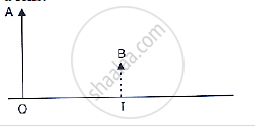Advertisements
Advertisements
प्रश्न
Convex lens : converging : : concave lens : _______
उत्तर
Convex lens : converging : : concave lens : diverging
APPEARS IN
संबंधित प्रश्न
If an object is placed 21 cm from a converging lens, the image formed is slightly smaller than the object. If the object is placed 19 cm from the lens, the image formed is slightly larger than object. The approximate focal length of the lens is ______.
Copy and complete the diagram below to show what happens to the rays of light when they pass through the concave lens:
Which type of lenses are:
thinner in the middle than at the edges?
What type of image is always made by a concave lens?
Fill in the following blank with suitable word:
A convex lens .................. rays of light, whereas a concave lens .................. rays of light.
Give the position, size and nature of image of formed by a concave lens when the object is placed:
at infinity.
Which type of lens is
a diverging lens? Explain your answer with diagrams.
When an object is placed 10 cm in front of lens A, the image is real, inverted, magnified and formed at a great distance. When the same object is placed 10 cm in front of lens B, the image formed is real, inverted and same size as the object.
What is the focal length of lens B?
When a fork is seen through lenses A and B one by one, it appears as shown in the diagrams. What is the nature of (i) lens A, and (ii) lens B? Give reason for your answer.
The power of a converging lens is 4.5 D and that of a diverging lens is 3 D. The power of this combination of lenses placed close together is :
(a) +1.5D
(b) +7.5D
(c) −7.5D
(d) −1.5D
Name one of the common defects of vision and the type of lens used to remove it.
Complete the following sentence:
A short-sighted person cannot see ............ objects clearly. Short-sightedness can be corrected by using ........... lenses.
The following diagram in given below shows an object OA and its virtual image IB formed by a lens.

An object is placed on the axis of a lens. An image is formed by refraction in the lens. For all positions of the object on the axis of the lens, the positions of the image are always always between the lens and the object name the lens.
An object of height 4 cm is kept at a distance of 30 cm from a concave lens. Use lens formula to determine the image distance, nature and size of the image formed if focal length of the lens is 15 cm.
A student obtained clear image of window grills on the screen. But the teacher told him to get the image of a tree far away, instead of window. To get a clear image, the lens must be ............................
A virtual diminished image is formed when an object is placed between the optical centre and the principal focus of a lens.
(i) Name the type of lens which forms the above image.
(ii) Draw a ray diagram to show the formation of the image with the above stated characteristics.
A concave lens has a focal length 30 cm. Find the position and magnification (m) of the image for an object placed in front of it at distance 30 cm. State whether the image is real or virtual?
State three characteristics of the image of an extended source, formed by a concave lens.
An object is placed in front of a lens between its optical centre and focus. The formed image is virtual, erect, and diminished. Name the lens used.
